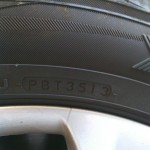- Tire pressure: The tire pressure on the door jamb is for the tires your vehicle came with when new. Although this can be a guide, use the sidewall rated pressures on your tires. You will get longer life and better gas mileage
- Rotate your tires every 5000 miles. You’ll get better life out of your tires
- Date code: Learn to read the date code on your tires. It will tell you how old the tires are and if they should be replaced. The National Highway Traffic Safety Administration (NHTSA) has no specific guidelines on tire aging and defers to the recommendations of carmakers and tire manufacturers. Carmakers such as Nissan and Mercedes-Benz tell consumers to replace tires six years after their production date, regardless of tread life. Tire manufacturers such as Continental and Michelin say a tire can last up to 10 years, provided you get annual tire inspections after the fifth year. If you drive 12 to 15 thousand miles per year it won’t be an issue but if it’s say, 6000 miles or less your tires may be age compromised. In the photo below the last 2 digits corresponds to the year built: in this case 2013 and the first digits is the week it was built in, the 35th week. Any letters before that is the manufacturer’s code.

- Size: It’s generally best to stick with the original size although if you want to change size consult with your tire professional on the safest options.
- Balance: Tire vibrations at higher speeds are almost always due to some form of tire imbalance. Sometimes a tire may wobble or pull badly at lower speeds and is likely due to some form of tire tread separation.
- Tread Pattern: All weather tires are not necessarily so. In climates that don’t drop below say 45 degrees or so that may be the case, but if you live where you have snow mixed with sleet and ice you might want to invest in some winter tires.
- Noise: Usually the tires you get on your new car are softer and inflated to the lower limits of the pressure recommendations in order to give you a soft and quieter ride. Generally speaking the harder the tire compounds the longer life you will get but the tradeoff may be more road noise.
- Tread wear: this is important to keep an eye on. Your tire professional or the automotive shop who does your regular maintenance should apprise you of any abnormal wear patterns. Tire wear in the middle indicates overinflated tires. Tire wear on both outside edges can indicate under inflation. Other abnormal wear patterns may indicate suspension or alignment problems that should be addressed. Some wear is simply due to a lack of tire rotation on schedule.
- What tires to buy: If you like the way your car performs, the answer is easy: Buy the exact same model you had. There’s a good reason—the tire and car companies spend nearly $1 million to develop a tire with the attributes that make you like your car. Ask yourself what you did and didn’t like about the previous tires – did they do well in the rain? The snow? Were they quiet enough? Did they last as long as you hoped?
- All wheel drive, anti-lock brakes, and traction control: if you have any of these and most cars come equipped with them these days, you need to replace your tires in sets of 4. The reason being, the processors for these devices count the wheel speed of each wheel. A new tire with three old tires may set a malfunction code. The new tires will spin at a different speed than the older tires due to its increased circumference. Below is a link to the NHTSA website to learn more about your tires.
http://www.nhtsa.gov/cars/rules/TireSafety/ridesonit/brochure.html

0 Comments